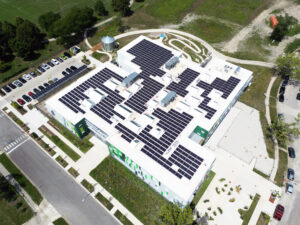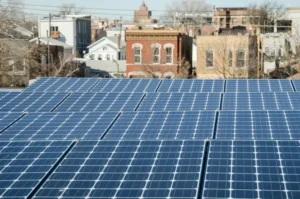Are you a homeowner in Illinois ready to unlock solar energy benefits? Discover bright ideas that can help you navigate the main installation costs, available incentives, and the use of solar savings calculators to make an informed decision that can reduce your electric bill and increase your property value.
What Are the Main Costs Involved in Solar Panel Installation in Illinois?
Solar installation costs in Illinois primarily include equipment (solar panels, inverters, mounting systems), labor, permitting fees, and expenses based on your energy consumption. The base equipment price is influenced by market trends and installer competition. Additional fees cover wiring, permits, and professional labor, while your monthly electricity usage determines the necessary system size.
How Does Solar Panel Cost Vary Across Illinois?
Costs vary due to regional market conditions, local labor rates, and state-specific incentives. In major metropolitan areas like Chicago, higher licensing fees and labor costs can increase prices. Generally, homeowners can expect prices between $2.50 and $3.50 per watt, with local weather and utility policies also playing a role.
What Are the Typical Installation and Permitting Fees?
Installation fees cover mounting systems, wiring, and inverter setup. Permitting fees, which ensure compliance with building codes, can range from $250 to $1,000, with installation labor sometimes accounting for up to 20% of the total cost.
How Does Energy Consumption Affect Your Solar Estimate?
Your monthly electricity use directly impacts the required system capacity. Homes with higher consumption typically need larger systems, leading to higher upfront costs but potential for greater long-term savings. Evaluating past utility bills helps determine the correct wattage and panel quantity needed.
Which Solar Energy Incentives in Illinois Can Lower Your Estimate?
Various federal, state, and local incentives help lower the upfront cost of solar installations. These include tax credits, rebates, and performance-based incentives that enhance the payback period and overall affordability of solar projects.
What Is the Federal Solar Tax Credit and How Does It Work?
The Federal Solar Tax Credit (Investment Tax Credit, ITC) lets you deduct about 30% of your installation costs from federal taxes. This credit significantly reduces upfront costs for both residential and commercial solar projects, making the investment more attractive.
How Does the Illinois Shines Program Benefit Homeowners?
The Illinois Shines Program offers rebates and performance-based incentives to reduce installation costs and shorten payback periods. It also provides incentives for energy storage, helping improve system efficiency during power outages.
Are There Additional Local or Utility Incentives Available?
Local utilities and municipalities may offer extra rebates, property tax exemptions, or low-interest loans. Researching these opportunities with your installer can uncover further ways to decrease your overall installed cost.
How Can You Use a Solar Savings Calculator to Get an Accurate Estimate?
A solar savings calculator estimates your potential savings by evaluating installation costs, future energy rates, and available incentives. By entering specific data, homeowners can forecast payback periods and long-term benefits to support their decision-making process.
What Inputs Do You Need for the Illinois Solar Savings Calculator?
Key inputs include current energy consumption (in kWh), local electricity rates, system capacity (in kW), cost per watt, and the expected annual increase in energy costs. Adding details about applicable tax credits and incentives helps produce a more accurate estimate.
How Does the Calculator Account for Energy Usage and Incentives?
The calculator uses your utility bills and projected rate increases to estimate savings over the solar system’s typical 25-year lifespan. It factors in both federal tax credits and state-specific incentives to adjust the net installation cost and predict the reduction in monthly electric bills.
Where Can You Find Reliable Solar Savings Calculators for Illinois?
Trusted sources for solar calculators include well-known solar providers, the National Renewable Energy Laboratory (NREL), and platforms like EnergySage. These tools are regularly updated to reflect current market conditions and incentive programs.
What Should Illinois Homeowners Look for When Choosing the Best Solar Companies?
Choosing the right solar installer is critical for accurate estimates and a smooth installation process. Key considerations include local expertise, company reputation, quality customer service, and warranty coverage. These factors affect both the installation experience and long-term system durability.
How Do Local Expertise and Customer Service Impact Your Solar Estimate?
Experienced local installers are better at assessing site conditions, handling permitting, and managing grid interconnection. Superior customer service ensures ongoing support, which helps reduce unexpected expenses and maximize savings over time.
What Are the Top-Rated Solar Providers in Illinois?
Reputable providers in Illinois, such as Windfree Solar, SolarTech Illinois, and SunPower Solutions, are known for extensive local experience, positive customer reviews, and robust certification records. They often offer free consultations and comprehensive maintenance plans.
How Do Company Warranties and Support Affect Long-Term Savings?
Long-term warranties on panels and inverters protect your investment against defects and future repair costs. Companies that offer warranties of 10 to 25 years for panels and 5 to 10 years for inverters, along with reliable support, help secure long-term savings.
How Does Net Metering Influence Your Residential Solar Estimate in Illinois?
Net metering allows solar system owners to receive credits for surplus energy fed back to the grid, effectively reducing monthly electric bills. It is a key factor in lowering overall energy costs for homeowners with solar installations.
What Is Net Metering and How Does It Work in Illinois?
Net metering credits homeowners when their panels generate more electricity than needed. Excess power is sent to the local grid, and the resulting credits reduce future electric bills based on state utility guidelines.
How Does Net Metering Impact Your Electricity Bill Savings?
By crediting surplus energy, net metering can lead to electricity bill reductions of 20% to 50%. This system is especially beneficial during high consumption months, making it a significant cost-saving advantage.
Are There Any Recent Changes to Illinois Net Metering Policies?
Recent policy adjustments in Illinois include modifications to credit rates and eligibility criteria. Homeowners should check with local utilities or the state energy department to stay informed about the latest regulations.
What Are the Five Essential Factors Illinois Homeowners Must Know to Get Their Solar Estimate Right?
An accurate solar estimate in Illinois is based on integrating key factors: cost calculations, incentive eligibility, energy usage, the choice of installer, and net metering benefits. Considering all these elements ensures a true picture of financial returns and efficiency.
How Do Cost, Incentives, and Energy Use Combine to Shape Your Estimate?
Combining the base equipment and installation costs with state and federal incentives and your energy consumption data enables you to calculate an accurate payback period and yearly savings. For instance, an installation initially costing $20,000 might effectively drop to $14,000 after incentives, while system size is adjusted based on consumption.
Why Is Choosing the Right Solar Company Critical for Accurate Estimates?
A reputable solar company conducts comprehensive site evaluations and provides clear, transparent pricing. This ensures all hidden costs are included and that any potential savings, including those from maintenance advice or future-proofing the system, are fully accounted for.
How Can You Verify and Compare Multiple Solar Estimates Effectively?
Using detailed comparison tables can help you assess different providers. Key metrics include installation costs per watt, incentive benefits, system size, warranties, and net metering support. For example:
| Provider Name | Base Cost (per watt) | Incentive Benefits (%) | Warranty (Years) | Net Metering Support |
| Windfree Solar | $3.00 | 30% (ITC & state) | 25/10 | Robust |
| SolarTech Illinois | $3.20 | 28% | 20/7 | Standard |
| SunPower Solutions | $2.95 | 32% | 25/10 | Advanced |
This table helps highlight competitive pricing, long-term benefits, and support quality.
Frequently Asked Questions
Q: How do I determine the right solar system size for my home?
A: Review past electricity bills and consult a professional to match your energy requirements with the appropriate system capacity.
Q: Can I still benefit from tax credits if I install solar panels?
A: Yes, both the Federal Solar Tax Credit and state programs help reduce overall installation costs.
Q: What impact will net metering have on my monthly bills?
A: Net metering offsets a significant portion of your electric bill by crediting excess power back to your account.
Q: Do local utility incentives vary significantly across Illinois?
A: Yes, incentives depend on your utility provider and region. It is advisable to verify opportunities locally.
Q: What should I do if my solar estimates differ markedly between providers?
A: Compare detailed quotes that include warranties, local expertise, and hidden fees to choose the best option.
Final Thoughts
Windfree Solar encourages you to leverage detailed solar estimates and take advantage of Illinois’ incentive programs. Understanding the cost components, tax credits, rebates, and using reliable savings calculators sets the stage for a sound renewable energy investment. Remember, partnering with a reputable solar company is as important as the efficiency of your system. Ready to explore your solar options? Call (312) 588-6953 or visit https://windfree.us/contact/ for a personalized quote and start your journey toward sustainable energy savings.




